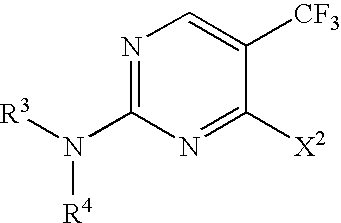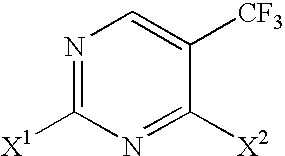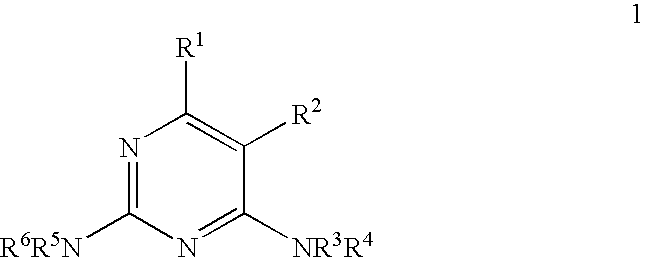Selective synthesis of CF3-substituted pyrimidines
a pyrimidine and cf3 technology, applied in the field of selective synthesis of cf3substituted pyrimidines, can solve the problems of limited utility and general difficulty in separation of the resulting isomers
- Summary
- Abstract
- Description
- Claims
- Application Information
AI Technical Summary
Benefits of technology
Problems solved by technology
Method used
Image
Examples
example 1
Preparation of 2,4-dichloro-5-trifluoromethylpyrimidine: 5-Trifluoromethyluracil
[0047](250 g, 1.39 mol) and phosphorous oxychloride (655 mL, 6.94 mol, 5 equiv) were charged to a 3 L 4-neck flask equipped with overhead stirrer, a reflux condenser, an addition funnel and an internal theromocouple. The contents were maintained under a nitrogen atmosphere as concentrated phosphoric acid (85 wt %, 9.5 mL, 0.1 equiv) was added in one portion to the slurry, resulting in a moderate exotherm. Diisopropylethylamine (245 mL, 1.39 mol, 1 equiv) was then added dropwise over 15 min at such a rate that the internal temperature of the reaction reached 85–90° C. by the end of the addition. By the end of the amine addition the reaction mixture was a homogenous light-orange solution. Heating was initiated and the orange solution was maintained at 100° C. for 20 h, at which time HPLC analysis of the reaction mixture indicated that the starting material was consumed. External heating was removed and the...
example 2
General Procedure for Non-Selective Amine Addition
[0048]Method A: A mixture of (2-Chloro-5-trifluoromethyl-pyrimidin-4-yl)-p-tolyl-amine (9) and (4-Chloro-5-trifluoromethyl-pyrimidin-2-yl)-p-tolyl-amine (8) To a solution of 5-trifluoromethyl-2,4-dichloropyrimidine (500 mg; 2.3 mmol) in DCE / t-butanol (20 mL) was added 4-methylaniline (247 mg; 1 eq) followed by dropwise addition triethylamine (1.1 eq). After stirring overnight the reaction was concentrated and taken up in ethyl acetate, washed with sat. NaHCO3, dried over Na2SO4, and the solvent removed. Analytical HPLC analysis revealed that the crude reaction contained a 1.4:1 mixture of 8:9. The resulting mixture of isomers was separated on a Shimadzu preparative HPLC system using a standard gradient (Waters XTerra Prep MS C18 column 5m, 50×50 mm; 0.1% NH4OH in 40–90% ACN / H2O 75 mL / min, 15 min gradient elution) to provide; (2-Chloro-5-trifluoromethyl-pyrimidin-4-yl)-p-tolyl-amine (9) (122 mg): 1H NMR (CDC3, 400 MHz) δ 2.35 (s, 3H),...
PUM
| Property | Measurement | Unit |
|---|---|---|
| Temperatures | aaaaa | aaaaa |
| temperature | aaaaa | aaaaa |
| interior diameter | aaaaa | aaaaa |
Abstract
Description
Claims
Application Information
 Login to View More
Login to View More - R&D
- Intellectual Property
- Life Sciences
- Materials
- Tech Scout
- Unparalleled Data Quality
- Higher Quality Content
- 60% Fewer Hallucinations
Browse by: Latest US Patents, China's latest patents, Technical Efficacy Thesaurus, Application Domain, Technology Topic, Popular Technical Reports.
© 2025 PatSnap. All rights reserved.Legal|Privacy policy|Modern Slavery Act Transparency Statement|Sitemap|About US| Contact US: help@patsnap.com



